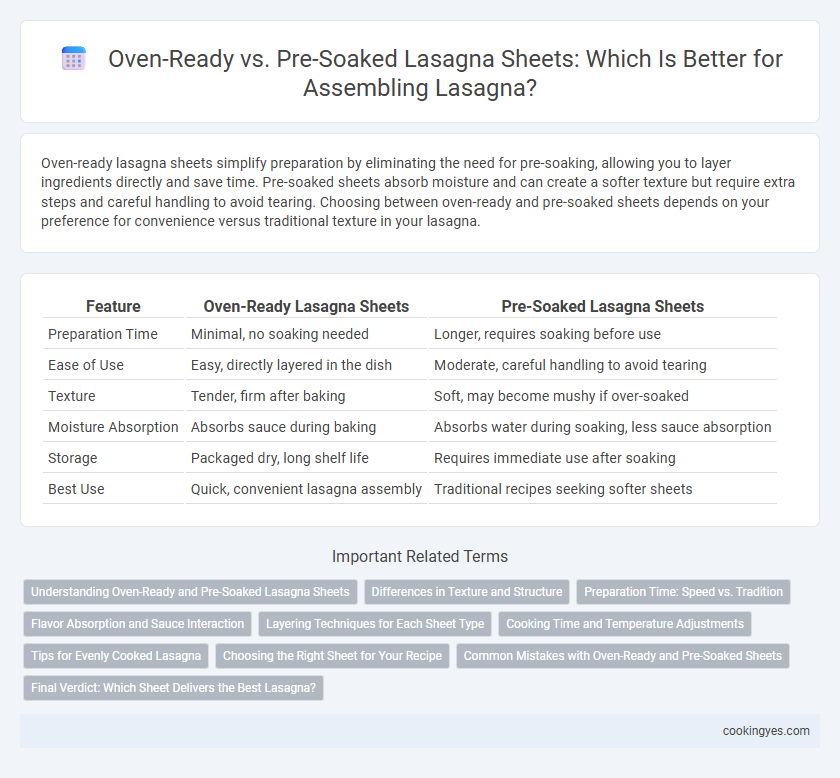Oven-ready lasagna sheets simplify preparation by eliminating the need for pre-soaking, allowing you to layer ingredients directly and save time. Pre-soaked sheets absorb moisture and can create a softer texture but require extra steps and careful handling to avoid tearing. Choosing between oven-ready and pre-soaked sheets depends on your preference for convenience versus traditional texture in your lasagna.
Table of Comparison
| Feature | Oven-Ready Lasagna Sheets | Pre-Soaked Lasagna Sheets |
|---|---|---|
| Preparation Time | Minimal, no soaking needed | Longer, requires soaking before use |
| Ease of Use | Easy, directly layered in the dish | Moderate, careful handling to avoid tearing |
| Texture | Tender, firm after baking | Soft, may become mushy if over-soaked |
| Moisture Absorption | Absorbs sauce during baking | Absorbs water during soaking, less sauce absorption |
| Storage | Packaged dry, long shelf life | Requires immediate use after soaking |
| Best Use | Quick, convenient lasagna assembly | Traditional recipes seeking softer sheets |
Understanding Oven-Ready and Pre-Soaked Lasagna Sheets
Oven-ready lasagna sheets offer convenience by eliminating the need for prior soaking, designed to absorb sauce and cook thoroughly during baking. Pre-soaked sheets require soaking in water to soften before layering, ensuring even texture and optimal absorption of flavors. Choosing between oven-ready and pre-soaked sheets depends on preparation time and desired lasagna consistency.
Differences in Texture and Structure
Oven-ready lasagna sheets are designed to absorb moisture slowly during baking, resulting in a firmer texture and more defined layers, while pre-soaked sheets offer a softer, creamier consistency due to their initial hydration. The structural integrity of oven-ready sheets supports a sturdy, sliceable lasagna with distinct pasta layers, whereas pre-soaked sheets tend to blend more seamlessly with sauces, creating a cohesive but less distinct layering. Choosing between the two affects the overall mouthfeel and presentation, with oven-ready sheets preferred for texture contrast and pre-soaked for a tender, unified dish.
Preparation Time: Speed vs. Tradition
Oven-ready lasagna sheets significantly reduce preparation time by eliminating the need for boiling or soaking before assembly, making them ideal for quick meals and convenience. Pre-soaked sheets, soaked in hot water until softened, adhere better to sauces and provide a traditional texture, but increase overall prep time by 10 to 15 minutes. Choosing oven-ready sheets balances speed with acceptable quality, while pre-soaked sheets prioritize authenticity and a more tender lasagna structure.
Flavor Absorption and Sauce Interaction
Oven-ready lasagna sheets are designed to absorb moisture directly from the sauce during baking, resulting in a more integrated flavor as the pasta softens without pre-soaking. Pre-soaked sheets allow for better initial sauce adhesion and can prevent dryness, but they may dilute the sauce's intensity if over-soaked. The choice between oven-ready and pre-soaked sheets impacts the overall texture and flavor absorption, with oven-ready sheets enhancing seamless sauce interaction throughout the lasagna layers.
Layering Techniques for Each Sheet Type
Oven-ready lasagna sheets allow for quicker layering since they absorb moisture from sauces during baking, eliminating the need for pre-soaking and maintaining a firmer texture between layers. Pre-soaked sheets require careful draining and gentle handling to avoid tearing, allowing for smoother, more pliable layers that blend seamlessly with cheeses and fillings. Adjusting sauce consistency is crucial with both sheet types to ensure proper hydration and prevent sogginess or dryness in each lasagna layer.
Cooking Time and Temperature Adjustments
Oven-ready lasagna sheets reduce overall cooking time by eliminating the need for pre-soaking, allowing assembly with minimal liquid and baking at standard temperatures around 350degF (175degC) for 45 minutes. Pre-soaked sheets require longer baking or higher moisture content in the sauce to ensure complete softening, often extending cooking time by 10-15 minutes or increasing oven temperature slightly to 375degF (190degC). Temperature adjustments depend on sheet type and moisture; oven-ready sheets cook evenly at consistent heat, while pre-soaked sheets benefit from gentler, longer baking to avoid drying out or uneven cooking.
Tips for Evenly Cooked Lasagna
Oven-ready lasagna sheets require no boiling and absorb moisture directly from the sauce, ensuring even cooking when layered with sufficient sauce to prevent dryness. Pre-soaked sheets offer flexibility by softening beforehand, allowing for controlled texture and reduced risk of undercooked pasta in denser lasagna layers. For evenly cooked lasagna, maintain consistent sauce moisture and cover with foil during baking to trap steam and promote uniform heat distribution.
Choosing the Right Sheet for Your Recipe
Oven-ready lasagna sheets streamline preparation by eliminating the need to pre-soak, absorbing moisture directly from sauces during baking for a tender texture. Pre-soaked sheets require soaking in water before assembly, which can help achieve a more pliable and evenly cooked pasta layer, especially in recipes with less sauce. Choosing the right sheet depends on sauce consistency and desired cooking time, with oven-ready sheets suited for moist, saucy recipes and pre-soaked sheets better for drier, layered lasagnas.
Common Mistakes with Oven-Ready and Pre-Soaked Sheets
Using oven-ready lasagna sheets often leads to uneven cooking when not enough sauce is applied, causing dry or undercooked pasta layers. Pre-soaked sheets can become overly soft and mushy if soaked for too long or layered without adequate sauce absorption time. A common mistake is neglecting to balance moisture levels with both types of sheets, which results in an inconsistent lasagna texture.
Final Verdict: Which Sheet Delivers the Best Lasagna?
Oven-ready lasagna sheets offer convenience and consistent texture by softening adequately during baking, making them ideal for quick assembly and evenly cooked layers. Pre-soaked sheets provide more control over tenderness and prevent overcooking but require extra preparation time and careful handling. The best lasagna outcome depends on balancing texture preference and preparation time, with oven-ready sheets favored for ease and reliable results, while pre-soaked sheets excel in crafting a customized, delicate final dish.
Oven-ready vs Pre-soaked sheets for assembling lasagna Infographic

 cookingyes.com
cookingyes.com